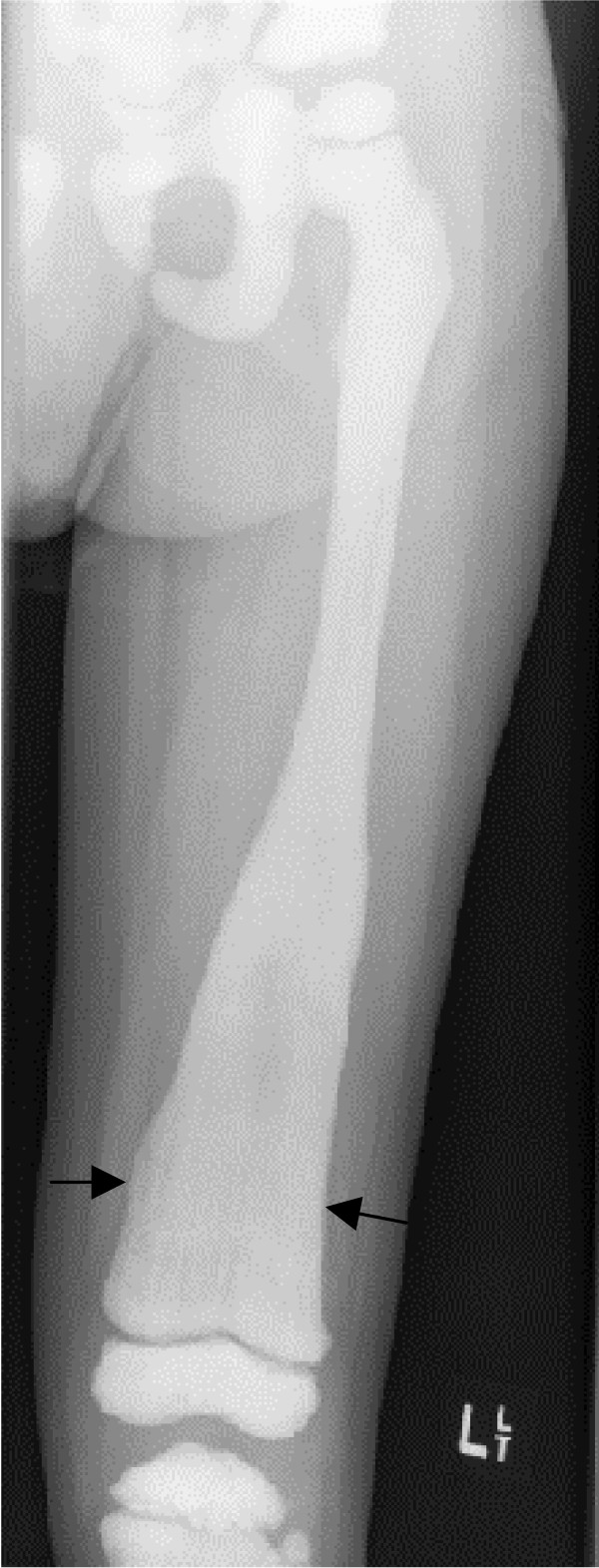WBR0474
| Author | [[PageAuthor::Yazan Daaboul, M.D. (Reviewed by Yazan Daaboul, M.D. and Alison Leibowitz [1])]] |
|---|---|
| Exam Type | ExamType::USMLE Step 1 |
| Main Category | MainCategory::Pathology |
| Sub Category | SubCategory::Musculoskeletal/Rheumatology |
| Prompt | [[Prompt::A 12-year-old boy is brought by his mother to the physician's office for multiple bone fractures. Although initial lab work-up reveals no abnormality, the diagnosis is initially suspected on x-ray of the femur (shown below). The diagnosis is then confirmed by genetic testing. Which of the following is the most likely diagnosis of this patient? |
| Answer A | AnswerA::Osteoporosis |
| Answer A Explanation | [[AnswerAExp::Osteoporosis is characterized by the loss of interconnections of trabeculated bone.]] |
| Answer B | AnswerB::Osteopetrosis |
| Answer B Explanation | [[AnswerBExp::Osteopetrosis is characterized by diffuse bone thickenening and Erlenmeyer flask appearance on x-ray.]] |
| Answer C | AnswerC::Paget's disease of the bone |
| Answer C Explanation | [[AnswerCExp::Paget's disease of the bone is characterized by abnormal bone architecture that manifests as a mosaic bone pattern and results in long bone chalk-stick fractures.]] |
| Answer D | AnswerD::Osteomalacia |
| Answer D Explanation | [[AnswerDExp::Osteomalacia is characterized by the defective mineralization or calcification of osteoid that is usually caused by vitamin D deficiency in adults. In contrast, vitamin D deficiency in children results in rickets.]] |
| Answer E | AnswerE::Polyostotic fibrous dysplasia |
| Answer E Explanation | [[AnswerEExp::Polyostotic fibrous dysplasia is characterized by the presence of irregular bone trabeculae due to the replacement of bone by fibroblasts.]] |
| Right Answer | RightAnswer::B |
| Explanation | [[Explanation::Osteopetrosis (marble bone disease) is a rare heritable disease characterized by increased bone density on imaging. Autosomal recessive (classic or malignant) form is severe and manifests as early fractures, short stature, compressive neuropathies, pancytopenia due to primary spongiosa filling the medullary cavity, hypocalcemia, and early death within the first 10 years of life. The autosomal recessive form is also associated with renal tubular acidosis and is thus thought to be involved in mutations of carbonic anhydrase II (CAII), an anion exchanger that has a role in kidney function and the provision of the acidic environment needed for bone resorption.
In contrast, the autosomal dominant form is more likely to manifest at older age during late childhood or adolescence, as presented in this vignette. Osteopetrosis is caused by failure of osteoclast development, differentiation, and function due to one of many genetic mutations. Osteopetrosis results in dense, thick bones that are paradoxically predisposed to fractures. A generalized increased bone density and an "Erlenmeyer flask" appearance of bones are characteristic on x-ray (shown below). Patients often present with multiple bone fractures, scoliosis, and mandible-osteomyelitis due to dental abscesses or caries. The diagnosis may be overlooked by lab work-up because serum values of calcium, phosphate, and alkaline phosphatase (ALP) are typically within normal limits in the autosomal dominant form. Treatment of ostepetrosis is generally symptomatic. Since the primary defect in osteopetrosis is abnormal functioning of osteoclasts, which are derived from monocyte lineage, bone marrow transplantation (BMT) is thought to be the only appropriate cure for patients with osteopetrosis.
|
| Approved | Approved::Yes |
| Keyword | WBRKeyword::Osteopetrosis, WBRKeyword::Marble bone disease, WBRKeyword::Erlenmeyer flask, WBRKeyword::X-ray, WBRKeyword::Osteoclasts, WBRKeyword::Bone resorption |
| Linked Question | Linked:: |
| Order in Linked Questions | LinkedOrder:: |
